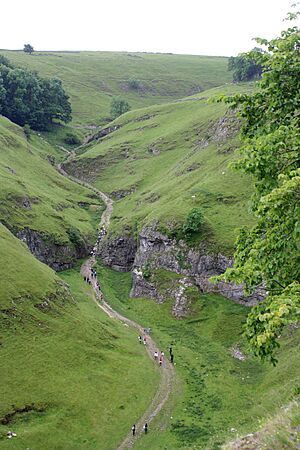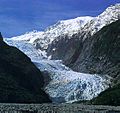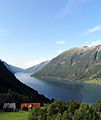Valley facts for kids

A valley is a low area of land found between higher parts, like hills or mountains. Valleys often start as a dip in the Earth's surface. Sometimes, they form as a rift valley, which is when the Earth's crust pulls apart.
Valleys are usually shaped and made deeper by a stream or river flowing from high land to lower land, eventually reaching a lake or sea. Some valleys are carved out by glaciers, which are slow-moving rivers of ice. When water or ice makes a valley deeper or wider, this process is called erosion. Even wind can help make valleys larger through erosion.
Every valley has a "head" where it begins, usually in mountains or hills. The "sides" are the slopes that rise up on either side. The "floor" is the flattest part at the bottom. Some valleys have an "entrance" where you can see the opening between two hills or mountains or cliffs. A very narrow valley with high walls is sometimes called a "gorge".
Many people live in valleys. This is because valleys often have a river or stream for fresh water. Also, the soil in valleys is often good for growing crops.
Contents
What Are the Different Types of Valleys?
Valleys in Mountainous Areas
Mountains and hills form when layers of rock and soil, called "strata," get folded. Some mountains, called fault block mountains, can have rift valleys. Valleys are found within mountain ranges, between the highest parts known as "peaks." People traveling across mountains often use valleys as their path. A valley used for travel through mountains or hills is called a mountain pass.
Valleys high in the mountains are usually made deeper by fast-flowing streams or small rivers. These rivers get their water from lots of rain or melting snow. The mountain stream flows around big rocks and washes away soil. It cuts a path through softer soil and smaller stones. Even a small stream can carve a very deep valley. Valleys in high mountains are typically V-shaped. You can find many such valleys in hills and mountains worldwide.
-
Iao Valley in Hawaii shows a perfect V-shape.
-
The Amendolea River winds between the mountains of Reggio-Calabria in Italy.
-
Mountains and valleys in the Czech Republic.
Valleys in Hilly Country
In areas with hills that are not very steep, a river or stream flows more slowly. This creates a wider valley, often with large bends as the river winds around the hills. Water flowing down from the hillsides often carries soil. This soil spreads out across the valley floor, creating flat land. This flat land is excellent for growing food crops and raising cattle and other animals. Many farms are located in these valleys. Many towns are also built on the sloping sides of valleys. Famous examples include the Loire Valley and the Lower Rhine Valley in Europe, and the Thames Valley in England.
-
The Loire Valley in France is famous for its old towns and castles.
-
Grapes for white wine are grown in the valley of the Moselle River in Germany.
-
Farmland in the valley of the Uruguay River in Argentina.
-
Farming in a valley in Zimbabwe.
Valleys in Flat Country
Some valleys are almost flat, like a large saucer. These valleys often have a very large river with many "tributaries." Tributaries are smaller streams that flow into the main river, like branches. They bring water from hills or mountains that might be far away.
After heavy rain, lots of water rushes into the main river. This causes the river to rise and flood the flat floor of the valley. When the floodwaters spread, they drop a lot of soil that has washed down from the hills. This soil creates a flat flood plain. These types of valleys are very good for growing food crops. The widest valleys in the world are like this. Famous examples include the Mississippi-Missouri Basin in North America, the Amazon Basin in South America, the Lower Danube in Europe, the Ganges River Valley in India, the Nile River Flood Plain in Africa, and the Darling River Basin in Australia.
Valleys Made by Glaciers
A glacier is like a frozen river. Not all countries have glaciers. A glacier begins in very high mountains where there is snow and ice all year. The snow and ice start to move down a valley that was already formed by a fast-flowing stream. As the ice slides down the mountainside, it doesn't flow around rocks. Instead, it pushes the rocks out of the way.
As a glacier moves, it picks up more ice and gets bigger. A large glacier cuts through the soil and softer rock of the valley. It piles up rocks on either side or pushes them in front of it. When a large glacier melts, it leaves behind a deep U-shaped valley. Many valleys like this were formed during the Ice Ages. In mountainous countries like Switzerland, many people live in valleys created by glaciers. Some of the world's deepest valleys were made by glaciers. The fjords of Norway and "sounds" of New Zealand are places where glaciers once reached the sea.
-
The Mattertal, a glacial valley in Switzerland, showing a recent landslide.
Valleys in Plateau Country
A plateau is high land that is flat on top, or gently rolling. It is not pointed like mountains or rounded like hills. In hilly or mountainous areas, soil and rock layers are folded. But in a plateau, these layers, or strata, are flat. Water that forms streams on top of a plateau cuts down into wide valleys. These valleys have steep cliff sides and a fairly flat bottom.
Valleys like this are often deep and very narrow. Some are very deep and wide, and these are called "canyons." Famous examples include the Grand Canyon in the United States and the Megalong Valley in Australia.
-
The Three Sisters in the Megalong Valley, NSW, Australia.
-
The Grand Canyon, Arizona, USA.
-
Sharyn River Canyon, Kazakhstan.
-
Foz de Arbayún in Spain.
Sunken Valleys
Sometimes, a valley forms in hills near a country's coast. Movements in the Earth's surface can cause the land to sink lower. When this happens, the valley can become flooded by the sea. You can still see the valley's shape from the tops of the hills that stick out of the water. Some of these hills might become islands, while others form the shore of a bay. Sunken valleys often make good harbors. The east coast of Australia has many sunken valleys. The most famous is Sydney Harbour.
Related Pages
Images for kids
-
Calchaquí Valleys in Argentina.
-
The Frades Valley in the mountainous region of Rio de Janeiro state, Brazil.
-
U-shaped valley on the Afon Fathew near Dolgoch, Wales.
-
Look from Paria View to a valley in Bryce Canyon, Utah, with very striking shoulders.
-
Indus River running through the Kohistan Valley in Pakistan.
-
The Harau Valley in West Sumatra, Indonesia.
-
A view of Orosí, Costa Rica.
See also
 In Spanish: Valle para niños
In Spanish: Valle para niños





























